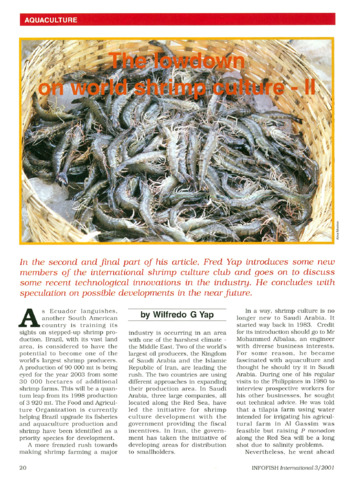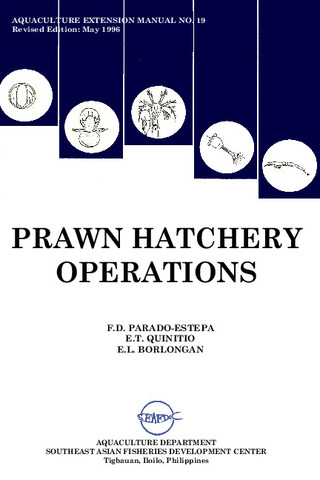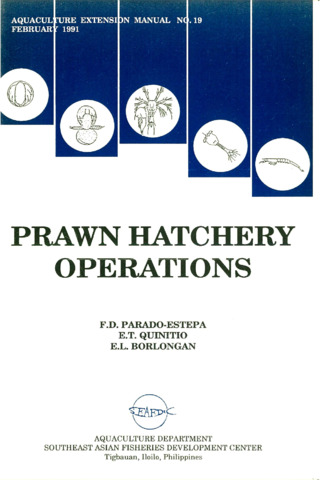Perlihatkan publikasi sederhana
Extensive and semi-intensive culture of prawn and shrimp in the Philippines
| dc.contributor.author | Apud, Florentino D. | |
| dc.contributor.editor | Taki, Yasuhiko | |
| dc.contributor.editor | Primavera, Jurgenne H. | |
| dc.contributor.editor | Llobrera, Jose A. | |
| dc.date.accessioned | 2011-06-22T09:34:57Z | |
| dc.date.available | 2011-06-22T09:34:57Z | |
| dc.date.issued | 1985 | |
| dc.identifier.citation | Apud, F. D. (1985). Extensive and semi-intensive culture of prawn and shrimp in the Philippines. In Taki, Y., Primavera, J. H., Llobrera, J. A. (Eds.), Proceedings of the First International Conference on the Culture of Penaeid Prawns/Shrimps, 4-7 December 1984 (pp. 105-113). Iloilo City, Philippines: Southeast Asian Fisheries Development Center, Aquaculture Department. | en |
| dc.identifier.isbn | 9718511008 | |
| dc.identifier.uri | http://hdl.handle.net/10862/249 | |
| dc.description.abstract | Various farming systems for prawn and shrimp are compared, with emphasis on the extensive and semi-intensive culture of tiger prawn Penaeus monodon and white shrimp Penaeus indicus in monoculture or in polyculture with milkfish (Chanos chanos). The bases of comparison include pond design characteristics, stocking density, food supply, water management, average production, technical, and other major input requirements. Common factors that may influence production for each system are also discussed. It is observed that prawn and shrimp production has been mainly characterized by the extensive system. Of the 200,000 ha of brackishwater fishponds in the Philippines, about 25% (50,000 ha) are stocked with prawns and shrimps in monoculture or in polyculture with milkfish. Only a relatively small portion (less than 500 ha) of the area is utilized for semi-intensive culture. The dramatic increase in area utilization for extensive prawn production in recent years can be attributed to high market demand, increased hatchery-bred fry production, minimum technical requirements, and lower production cost and risks. The trend towards intensification among existing large fishfarms is hampered by rising capital costs for fishpond improvement and increasing operational expense and risks. However, intensification is gaining some attention and progress in limited areas, primarily to maximize utilization and production to avoid high investment cost of land for expansion. Further development and progress in the industry will be dependent on such factors as market price, availability of fry and feed at reasonable cost, supply of trained technicians, technical problems, financial situation, and economic viability of the operation. | en |
| dc.language.iso | en | en |
| dc.publisher | Aquaculture Department, Southeast Asian Fisheries Development Center | en |
| dc.subject | Crustacea | en |
| dc.subject | Semi-intensive culture | en |
| dc.subject | Philippines | en |
| dc.subject | Giant tiger shrimp | en |
| dc.subject | prawns and shrimps | en |
| dc.subject | Penaeus monodon | en |
| dc.subject | Penaeus indicus | en |
| dc.subject.lcc | VF SP 031 | |
| dc.title | Extensive and semi-intensive culture of prawn and shrimp in the Philippines | en |
| dc.type | Conference paper | en |
| dc.citation.spage | 105 | |
| dc.citation.epage | 113 | |
| dc.citation.conferenceTitle | Proceedings of the First International Conference on the Culture of Penaeid Prawns/Shrimps, 4-7 December 1984, Iloilo City, Philippines | en |
| dc.subject.asfa | shrimp culture | en |
| dc.subject.asfa | extensive aquaculture | en |
| dc.subject.asfa | aquaculture systems | en |
| dc.subject.scientificName | Penaeus monodon | en |






